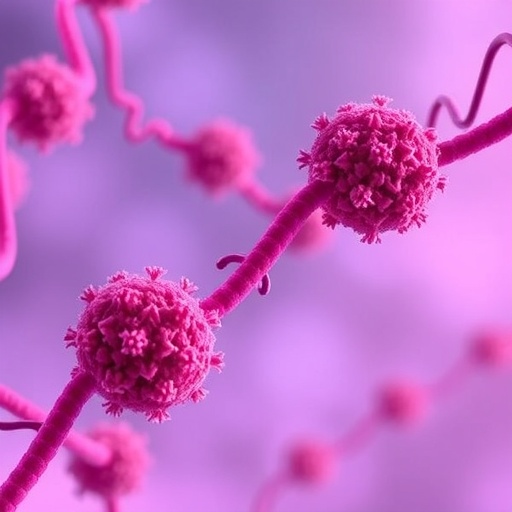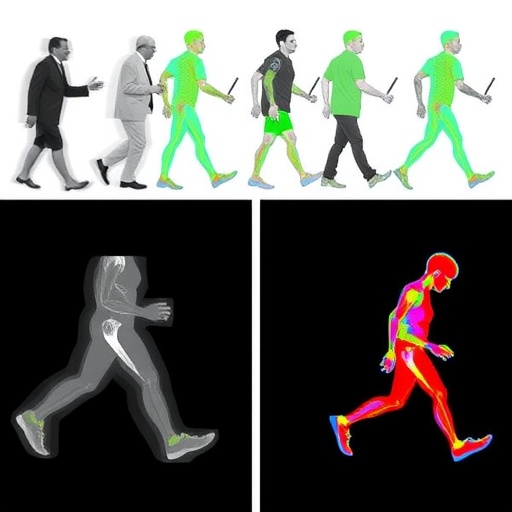CHAPEL Hill – While obesity has been shown to increase breast cancer risk in postmenopausal women, a large-scale study co-led by a University of North Carolina Lineberger Comprehensive Cancer Center researcher found the opposite is true for premenopausal women: higher body fat was linked to lower breast cancer risk.
The findings, published in the journal JAMA Oncology, show the need to better understand breast cancer risk factors in younger women before menopause, said UNC Lineberger's Hazel B. Nichols, PhD.
"The drivers of breast cancer risk can be different for young women compared to older women, so we need to do a better job of understanding what contributes specifically to breast cancer risk in younger women so we can make appropriate recommendations for them," said Nichols, who is an assistant professor in the UNC Gillings School of Global Public Health. "This study is not a reason to try to gain weight to prevent breast cancer. Heavier women have a lower overall risk of breast cancer before menopause, but there are a lot of other benefits to managing a healthy weight that should be considered. What it does do is help us to try to understand what contributes to breast cancer risk in younger women."
Breast cancer is most common in older women, with a median age of diagnosis at 62 in the United States. Obesity has been linked to higher risk for breast cancer in women after menopause, which occurs, on average, at age 51 in the United States.
Since breast cancer is less common in younger women, researchers pooled data from 19 different studies to investigate breast cancer risk for a group of 758,592 women who were younger than 55 years.
"Studies often have smaller numbers of premenopausal breast cancers since breast cancer is less common at younger ages, and the evidence was not as strong as for postmenopausal breast cancer," Nichols said.
Their analysis linked a higher body mass index, or BMI, to lower breast cancer risk for younger women across this age group, even for women within a normal weight range.
"We saw a trend where, as BMI went up, cancer risk went down," Nichols said. "There was no threshold at which having a higher BMI was linked to lower cancer risk."
The largest reductions in risk were for BMI between the ages of 18 and 24, with a 23 percent lower breast cancer risk linked to each five-unit increase in BMI during this time period. At ages 25 to 34, each five-unit increase in BMI was linked to 15 percent lower risk. There was a 13 percent lower risk for BMI at ages 35 to 44, and a 12 percent lower risk for BMI at ages 45 to 54 years.
They also saw the risk decreases linked to higher body mass index for estrogen- or progesterone-receptor positive breast cancer, but they did not see a consistent relationship for BMI and triple negative breast cancer, or hormone-receptor negative breast cancer.
Nichols said multiple factors could be contributing to the link between higher BMI and lower breast cancer risk in younger women, such as differences in hormones, including estrogen, growth factors, or breast density. Estrogen can be a driver of breast cancer, but there are different levels and sources of estrogen before and after menopause. Before menopause onset, the primary source of estrogen comes from the ovaries, and estrogen produced by fatty tissue may help to downregulate the amount of estrogen produced by the ovaries.
"The amount of estrogen produced by your ovaries is driven by feedback loops in your body," Nichols said. "The small amount of estrogen produced by fat tissue before menopause may help tell the ovaries that they can produce less estrogen and also regulate other hormones or growth factors." Nichols said that after menopause, women with higher adipose tissue have higher estrogen levels.
"After menopause, the ovaries are no longer the primary source of estrogen," she said. "Instead, most estrogens come from adipose, or fat, tissue," she said. "Women who have more adipose tissue after menopause usually have higher levels of estrogen which can contribute to higher breast cancer risk. In young women, estrogen is one factor that contributes, but it's not the whole story."
To further their investigation of breast cancer risk factors, Nichols said the group will take a closer look at patterns of risk according to weight change in early-to-mid-adulthood and will also consider the role of pregnancy, and other factors that may be important to consider for breast cancer risk at younger ages.
"Although breast cancer is more common at older ages, it's actually the most common type of cancer diagnosed among reproductive-aged women," Nichols said. "Understanding risk factors that may operate differently before menopause is critical to reducing breast cancer risk in young women, but these factors are hard to study in traditional settings where there are fewer young women in cancer research. The Premenopausal Breast Cancer Collaborative Group, which was founded by investigators at UNC, the National Institute of Environmental Health Sciences in North Carolina and the Institute of Cancer Research in London, gives us a way forward to investigate breast cancer in younger populations."
###
In addition to Nichols, the co-first and co-senior authors were Minouk J. Schoemaker, PhD and Anthony J. Swerdlow, DM, DSc, at the Institute of Cancer Research in London, and Dale P. Sandler, PhD, at the National Institute of Environmental Health Sciences. The other authors were: Lauren B. Wright, MSc; Mark N. Brook, PhD; Michael E. Jones, PhD; Katie M. O'Brien, PhD; Hans-Olov Adami, MD, PhD; Laura Baglietto, PhD; Leslie Berstein, PhD; Kimberly Bertrand, ScD; Marie-Christine Boutron-Ruault, MD, PhD; Tonje Braaten, PhD; Yu Chen, MPH, PhD; Avonne E. Connor, PhD; Miren Dorronsoro, MD; Laure Dossus, PhD; A. Heather Eliassen, ScD; Graham G. Giles, PhD; Susan E. Hankinson, ScD: Rudolf Kaaks, PhD; Timothy J. Key, DPhil; Victoria A. Kirsh, PhD: Cari M. Kitahara, PhD; Woon-Pua Koh, PhD; Susanna C. Larsson, PhD; Martha S. Linet, MD; Huiyan Ma, PhD; Giovanna Masala, MD; Melissa A. Merritt, PhD; Roger L. Milne, PhD; Kim Overvad, PhD; Kotaro Ozasa, MD, PhD; Julie R. Palmer, ScD; Petra H. Peeters, MD, PhD; Elio Riboli, MD; Thomas E. Rohan, MBBS, DHSc; Atsuko Sadakane, MD, PhD; Malin Sund, MD, PhD; Antonia Trichopoulou, MD, PhD; Giske Ursin, MD, PhD; Lars Vatten, MD, PhD; Kala Visvanathan, MD; Elisabethe Weiderpass, MD, PhD; Walter C. Willett, MD, DrPH; Alicja Wolk, DRMedSc, PhD; Jian-Min Yuan, MD, PHD; and Anne Zeleniuch-Jacquotte, MD, MS.
The study was supported by Breast Cancer Now and United Kingdom National Health Service funding to the Royal Marsden/ICR NIHR Biomedical Research Centre; the Institute of Cancer Research London; the Avon Foundation; the U.S. National Center for Advancing Translational Sciences; Karolinska Institute Distinguished Professor Award; the National Institutes of Health; the National Institute of Environmental Health Sciences; National Cancer Institute; the National Program of Cancer Registries of the Centers for Disease Control and Prevention; the Department Of Energy; the Dahod Breast Cancer Research Program at Boston University School of Medicine; the state of Maryland; and Maryland Cigarette Restitution Fund; VicHealth; Cancer Council Victoria; the Australia National Health & Medical Research Council; the Breast Cancer Research Foundation; Swedish Research Council and Swedish Cancer Foundation; the Japanese Ministry of Health, Labor and Welfare; and the Hellenic Health Foundation. The coordination of the European Prospective Investigation in Cancer is financially supported by the European Commission and the International Agency for Research on Cancer. The national cohorts are supported by Danish Cancer Society (Denmark); Ligue Contre le Cancer, Institut Gustave Roussy, Mutuelle Generale de 405 l'Education Nationale, Institut National de la Santé et de la Recherche Medicale (INSERM; France); German Cancer Aid, German Cancer Research Center (DKFZ), Federal Ministry of Education and Research (BMBF), Deutsche Krebshilfe, Deutsches Krebsforschungszentrum and Federal Ministry of Education and Research (Germany); the Hellenic Health Foundation (Greece); Associazione Italiana per la Ricerca sulCancro-AIRC-Italy and National Research Council (Italy); Dutch Ministry of Public Health, Welfare and Sports (VWS), Netherlands Cancer Registry (NKR), LK Research Funds, Dutch Prevention Funds, Dutch ZON (Zorg Onderzoek Nederland), World Cancer Research Fund (WCRF), Statistics Netherlands (The Netherlands); ERC-2009-AdG 232997 and Nordforsk, Nordic Centre of Excellence program on Food, Nutrition and Health (Norway); Health Research Fund (FIS), PI13/00061 to Granada, PI13/01162 to EPIC-Murcia, Regional Governments of Andalucía, Asturias, Basque Country, Murcia and Navarra, ISCIII RETIC (RD06/0020; Spain); Swedish Cancer Society, Swedish Research Council and County Councils of Skane and Västerbotten (Sweden); Cancer Research UK (14136 to EPIC-Norfolk; C570/A16491 and C8221/A19170 to EPIC-Oxford), Medical Research Council (1000143 to EPIC-Norfolk, MR/M012190/1 to EPIC-Oxford; United Kingdom).
Media Contact
Laura Oleniacz
[email protected]
919-445-4219
http://cancer.med.unc.edu/
https://unclineberger.org/news/higher-body-fat-linked-to-lower-breast-cancer-risk-in-younger-women




